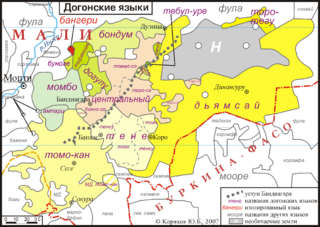Bangime language
| Bangime | |
|---|---|
| Baŋgɛri-mɛ | |
| Region | Dogon cliffs, Mali |
Native speakers | 2,000 (2005)[1] |
| Language codes | |
| ISO 639-3 | dba |
| Glottolog | bang1363 |
| ELP | Bangime |
 Bangi-me, among the Dogon languages | |
The Bangime /ˌbæŋɡiˈmeɪ/ (bàŋɡí–mɛ̀) language, or in full Bàŋgɛ́rí-mɛ̀,[2] is a language isolate spoken by 1,500 ethnic Dogon in seven villages in southern Mali, who call themselves the bàŋɡá–ndɛ̀ ('hidden people'). Long known to be highly divergent from (other) Dogon languages, it was first proposed as a possible isolate by Blench (2005). Research since then has confirmed that it appears to be unrelated to neighboring languages.
Roger Blench, who discovered the language was not Dogon, notes,
- This language contains some Niger–Congo roots but is lexically very remote from all other languages in West Africa. It is presumably the last remaining representative of the languages spoken prior to the expansion of the Dogon proper,
which he dates to 3,000–4,000 years ago.
Bangime has been characterised as an anti-language, i.e. a language that serves to distinguish its speakers from a wider population, possibly associated with the Bangande villages having been a refuge for escapees from slave caravans.[3]
Blench (2015) suggests that Bangime and Dogon languages may have a substratum from a "missing" branch of Nilo-Saharan that had split off relatively early from Proto-Nilo-Saharan, and tentatively calls that branch "Plateau".[4]
Locations
Bangime is spoken in 7 villages east of Karge, near Bandiagara, Mopti Region, central Mali (Blench 2007).
- Bara (IPA: [bara])
- Bounou (IPA: [bunu])
- Niana (IPA: [ɲana])
- Die'ni (IPA: [jene])
- Digari (IPA: [diɡarɔ])
- Doro (IPA: [dɔrɔ])
- Due (IPA: [ʔjeni])
Morphology
Bangime is an isolating language. The only productive affixes are the plural and a diminutive, which are seen in the words for the people and language above.
Phonology
Vowels have an ±ATR distinction, which affects neighboring consonants, but unusually for such systems, there is no ATR vowel harmony in Bangime. The vowels are /i ɪ e ɛ a ɔ o ʊ u/. Vowels may be long or nasalized.
There are three tones on moras (short syllables): high, low, and rising. In addition, falling tone may occur on long (bimoraic) syllables. Syllables may also have no inherent tone.
Bangime has consonant distinctions not found in the Dogon languages.
| m | n | ɲ | ŋ |
| p | t | k | |
| b | d | ɡ | |
| s | ɕ | ||
| l | j ɥ | w |
NC sequences tend to drop the plosive, and often lenite to a nasalized sonorant: [búndà] ~ [búr̃a] ~ [bún] 'finish', [támbà] ~ [táw̃à] ~ [támà] 'chew'.
/b/ and /ɡ/ appear as [ʋ] and [ɣ], depending on the ATR status of the adjacent vowels.
/s/ appears as [ʃ] before non-low vowels, /t/ and /j/ as [tʃ] and [ʒ] before either of the high front vowels. /j/ is realized as [dʒ] after a nasal.
Notes
- ^ Bangime at Ethnologue (18th ed., 2015) (subscription required)
- ^ /Vr/ sequences are frequently dropped. The language has also been called Numadaw, which is part of a greeting.
- ^ Bradley, Matthew Timothy (2014-05-31). "The 'secret ones': tales from Mali's anti-language". New Scientist. 222 (2971): 42–45. doi:10.1016/S0262-4079(14)61070-8.
- ^ Blench, Roger. 2015. Was there a now-vanished branch of Nilo-Saharan on the Dogon Plateau? Evidence from substrate vocabulary in Bangime and Dogon.
References
- Blench, Robert, Bangime description and word list (2005)(2007)
- Hantgan & Vydrin, "Bangime, Justification as a Language Isolate", presented at the Language Isolates in Africa workshop, Lyons, December 4, 2010
- Hantgan, Abbie, A Grammar of Bangime[1] (draft, 2010)
- Hantgan, Abbie (July 2013). Aspects of Bangime phonology, morphology, and morphosyntax (Ph.D. thesis). Indiana University. OCLC 893980514.
External links
- Bangime at the Dogon languages and Bangime project
